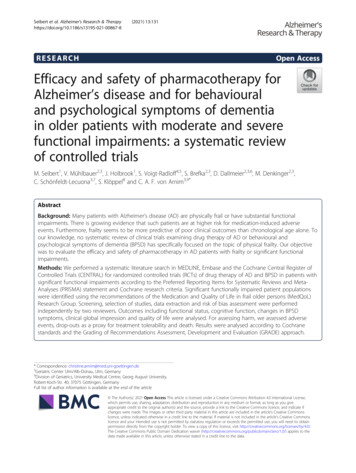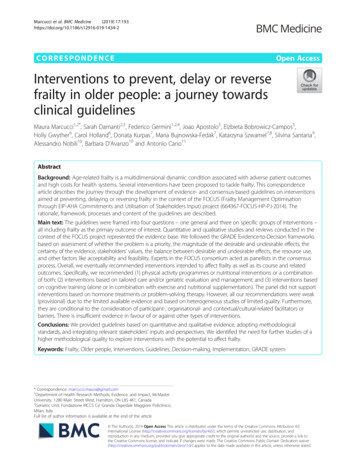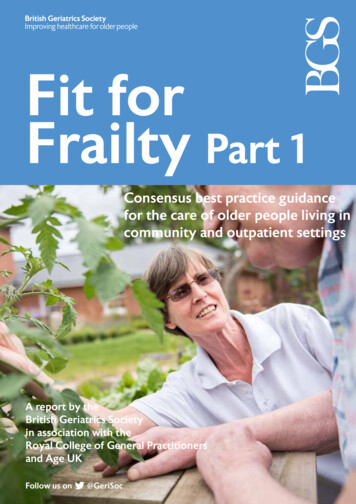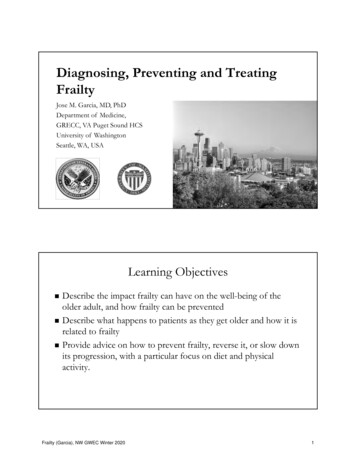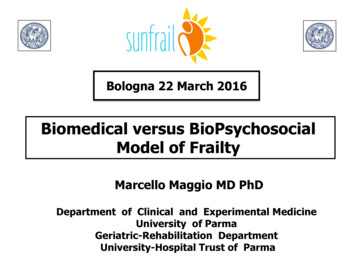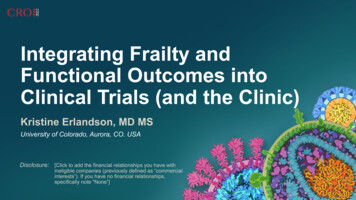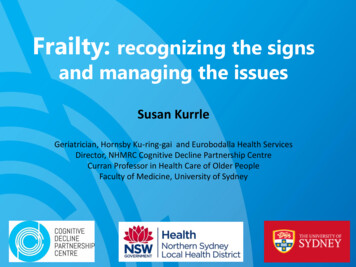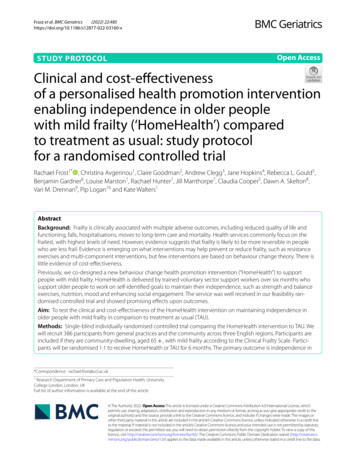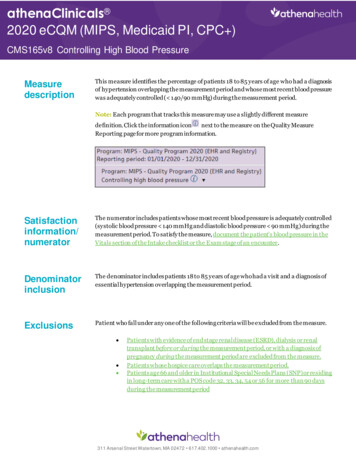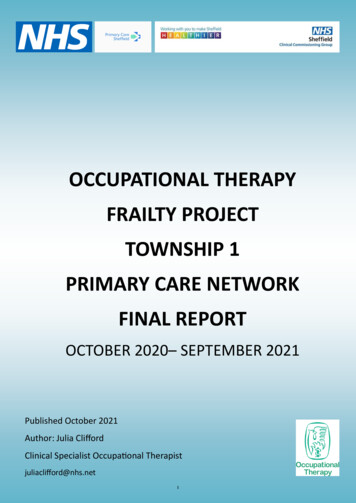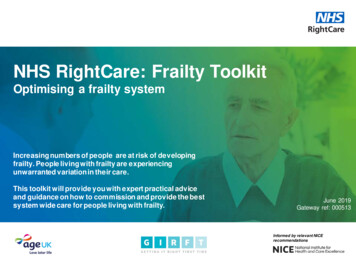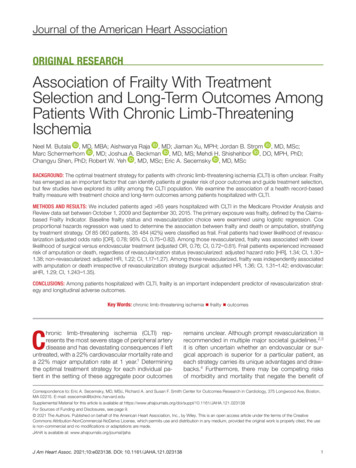
Transcription
Journal of the American Heart AssociationORIGINAL RESEARCHAssociation of Frailty With TreatmentSelection and Long- Term Outcomes AmongPatients With Chronic Limb- ThreateningIschemiaNeel M. Butala , MD, MBA; Aishwarya Raja , MD; Jiaman Xu, MPH; Jordan B. Strom , MD, MSc;Marc Schermerhorn , MD; Joshua A. Beckman , MD, MS; Mehdi H. Shishehbor , DO, MPH, PhD;Changyu Shen, PhD; Robert W. Yeh , MD, MSc; Eric A. Secemsky , MD, MScBACKGROUND: The optimal treatment strategy for patients with chronic limb- threatening ischemia (CLTI) is often unclear. Frailtyhas emerged as an important factor that can identify patients at greater risk of poor outcomes and guide treatment selection,but few studies have explored its utility among the CLTI population. We examine the association of a health record- basedfrailty measure with treatment choice and long- term outcomes among patients hospitalized with CLTI.METHODS AND RESULTS: We included patients aged 65 years hospitalized with CLTI in the Medicare Provider Analysis andReview data set between October 1, 2009 and September 30, 2015. The primary exposure was frailty, defined by the Claims- based Frailty Indicator. Baseline frailty status and revascularization choice were examined using logistic regression. Coxproportional hazards regression was used to determine the association between frailty and death or amputation, stratifyingby treatment strategy. Of 85 060 patients, 35 484 (42%) were classified as frail. Frail patients had lower likelihood of revascularization (adjusted odds ratio [OR], 0.78; 95% CI, 0.75‒ 0.82). Among those revascularized, frailty was associated with lowerlikelihood of surgical versus endovascular treatment (adjusted OR, 0.76; CI, 0.72‒ 0.81). Frail patients experienced increasedrisk of amputation or death, regardless of revascularization status (revascularized: adjusted hazard ratio [HR], 1.34; CI, 1.30‒ 1.38; non- revascularized: adjusted HR, 1.22; CI, 1.17‒ 1.27). Among those revascularized, frailty was independently associatedwith amputation or death irrespective of revascularization strategy (surgical: adjusted HR, 1.36; CI, 1.31‒ 1.42; endovascular:aHR, 1.29; CI, 1.243‒ 1.35).CONCLUSIONS: Among patients hospitalized with CLTI, frailty is an important independent predictor of revascularization strategy and longitudinal adverse outcomes.Key Words: chronic limb- threatening ischemia frailty outcomesChronic limb- threatening ischemia (CLTI) represents the most severe stage of peripheral arterydisease and has devastating consequences if leftuntreated, with a 22% cardiovascular mortality rate anda 22% major amputation rate at 1 year.1 Determiningthe optimal treatment strategy for each individual patient in the setting of these aggregate poor outcomesremains unclear. Although prompt revascularization isrecommended in multiple major societal guidelines,2,3it is often uncertain whether an endovascular or surgical approach is superior for a particular patient, aseach strategy carries its unique advantages and drawbacks.4 Furthermore, there may be competing risksof morbidity and mortality that negate the benefit ofCorrespondence to: Eric A. Secemsky, MD, MSc, Richard A. and Susan F. Smith Center for Outcomes Research in Cardiology, 375 Longwood Ave, Boston,MA 02215. E- mail: esecemsk@bidmc.harvard.eduSupplemental Material for this article is available at https://www.ahajo urnals.org/doi/suppl/ 10.1161/JAHA.121.023138For Sources of Funding and Disclosures, see page 9. 2021 The Authors. Published on behalf of the American Heart Association, Inc., by Wiley. This is an open access article under the terms of the CreativeCommons Attribution- NonCommercial- NoDerivs License, which permits use and distribution in any medium, provided the original work is properly cited, the useis non- commercial and no modifications or adaptations are made.JAHA is available at: www.ahajournals.org/journal/jahaJ Am Heart Assoc. 2021;10:e023138. DOI: 10.1161/JAHA.121.023138 1
Butala et al Frailty and CLTI Treatment and OutcomesCLINICAL PERSPECTIVEWhat Is New? Among patients hospitalized with chroniclimb- threatening ischemia, frailty is an important independent predictor of revascularizationstrategy and longitudinal adverse outcomes. Frail patients with chronic limb- threatening ischemia were less likely to receive aggressivetreatments and more likely to experience deathor amputation, regardless of treatment strategy.What Are the Clinical Implications? Clinicians should assess frailty in patients withchronic limb- threatening ischemia and use suchinformation to guide shared decision- makingwith patients about their prognosis and the various treatment options available, ranging frominvasive surgical revascularization to palliation.Nonstandard Abbreviations and AcronymsAFSCFICLTIamputation- free survivalClaims- based Frailty Indicatorchronic limb- threatening ischemiarevascularization altogether and may favor palliation.As such, it is critical that factors associated with prognosis are identified and used to guide clinical decision- making to improve CLTI outcomes.Prior attempts at creating clinical risk stratification toolshave focused on traditional comorbidities and their cumulative burden.5– 10 However, these characteristics may notfully represent a patient’s risk or candidacy for a specificinvasive strategy. Recently, frailty has emerged as an important prognostic factor that can guide treatment selection and help identify patients with cardiovascular diseaseat greater risk of poor outcomes.11– 13 Multiple methodshave been adopted to measure frailty, including in- personand health record- based assessments. Despite thedemonstrated utility of identifying patients with cardiovascular disease who are frail, the extension of these methods to larger CLTI populations is limited.14,15Therefore, this study involving patients hospitalized with CLTI aimed to examine the association of ahealth record- based frailty measure with: (1) treatmentchoice and (2) outcomes. Such results can not onlyhelp inform shared decision- making with patients onCLTI treatment options but can also help guide futurestudies examining the optimal treatment strategy forpatients with CLTI.METHODSStudy PopulationWe included all unique adults aged 66 years withan inpatient hospitalization for CLTI in the Centers forMedicare and Medicaid Services Medicare ProviderAnalysis and Review (MedPAR) database betweenOctober 1, 2009 and September 30, 2015. The cut- off of the study corresponded with the transition tothe International Classification of Diseases, TenthRevision (ICD- 10) coding, as the frailty measure usedin this study relies on the International Classificationof Diseases, Ninth Revision (ICD- 9) claims codes andhas yet to be validated in ICD- 10. CLTI hospitalizationswere identified based on whether patients had a primary discharge diagnosis code for atherosclerosis ofarteries of the extremities with rest pain (440.22), ulceration (440.23), or gangrene (440.24), as has beendone previously (Table S1).16 CLTI hospitalizations wereexcluded if patients did not have at least 1 continuous year of data within the MedPAR data set beforethe CLTI episode, since these data were used to ascertain comorbidities, or if patients had a previousdiagnosis of CLTI in this 1- year lookback period. Wealso excluded CLTI hospitalizations if patients died orreceived a major amputation during the index hospitalization, as we aimed to examine a population that wastheoretically considered for a revascularization strategyas a definitive CLTI treatment. After exclusion criteriawere applied, the first CLTI hospitalization for each patient was included in our study. The data that supportthe findings of this study are available from the corresponding author upon reasonable request.ExposureThe primary exposure in the study was frailty, as measured by the Claims- based Frailty Indicator (CFI) developed by Segal et al,17 based on administrative claimsin the 12 months before CLTI admission. The CFI is a21- variable indicator derived from a lookback of primarily ICD- 9 administrative claims that was validatedagainst the Fried Frailty Phenotype, a clinical tool formeasuring frailty, in the Cardiovascular Health Study(Tables S2 and S3). We examined an ICD- 9 code inany position in any of the admissions in the 12- monthlookback period to identify frailty. The CFI has subsequently been externally validated,18 and has been usedextensively in studies of populations with cardiovascular disease.12,13 Notably, this frailty measure does notdirectly include many of the traditional cardiovascularrisk factors (eg, hypertension, hyperlipidemia, diabetes, obesity, smoking status), though it does considercongestive heart failure and stroke. For this study,we ascertained frailty status based on ICD- 9 codesfrom inpatient admissions in the year before the CLTIJ Am Heart Assoc. 2021;10:e023138. DOI: 10.1161/JAHA.121.023138 2
Butala et al hospitalization. We used the established CFI thresholdof 0.25 to define frailty.17 We also performed multiplesensitivity analyses using different CFI score thresholds to supplement these results, as outlined below.CharacteristicsPatient characteristics included demographics (age,sex, race), Elixhauser comorbidities,19 and current orprior tobacco use given known prior associations between these variables and outcomes. All comorbiditieswere ascertained during the 1- year lookback period.Revascularization was defined as either endovascular or surgical using claims- based ICD- 9 procedurecodes from the index hospitalization (Table S1).16,20 If arevascularization code was not found during the indexadmission, a patient was considered not to have hadrevascularization. Patients who underwent revascularizations with both surgical and endovascular types ofprocedures during the same index hospitalization contributed data to the surgical revascularization group.OutcomesThe primary outcome was amputation- free survival(AFS) measured from the discharge date. Amputationwas defined as any major amputation and was identified through validated ICD- 9 and ICD- 10 coding algorithms (Table S1).16,20 Mortality was determined using thevital status information from the Medicare BeneficiarySummary File. Secondary outcomes included theindividual components of the composite outcome.Follow- up data were available through December 2017.Statistical AnalysisAll metrics and normally distributed variables werereported as mean SD. Non- normally distributed variables were presented as median (interquartile range).Categorical variables were presented as frequencyand percentage. Baseline characteristics were compared between those who were frail and not frail usingstandardized differences. A standardized difference 10% was considered significant.21The association between frailty status and revascularization among patients with CLTI was then examined. Crude rates of revascularization versus norevascularization were compared by frailty status usingchi- squared tests. Multivariable logistic regression wasused to determine the adjusted association betweenrevascularization and frailty status. The first modelevaluated the association between revascularization(compared with no revascularization) and frailty statusamong all patients with CLTI, adjusting for demographics, Elixhauser comorbidities, and tobacco use. Thesecond model evaluated the association between surgical revascularization (compared with endovascularFrailty and CLTI Treatment and Outcomesrevascularization) and frailty status among all patientswho underwent a revascularization procedure, againadjusting for demographics, Elixhauser comorbidities,and tobacco use.Finally, the association between frailty status andoutcomes was analyzed, stratified by treatment strategy. Kaplan‒ Meier methods were used to estimate AFSby frailty status among patients who did not receiverevascularization and, separately, among patients whoreceived revascularization. In addition, among patientswho received revascularization, patients were stratifiedby frailty status among those receiving endovasculartreatment and, separately, surgical treatment. Cox proportional hazards regression was then used to evaluatethe association between frailty status and outcomes, adjusted for patient characteristics. The proportional hazards assumption was evaluated by plotting the hazardratios (HRs) between frail and non- frail individuals withsurvival over time (Figure S1). Because of the possibility of unmeasured confounding and treatment selectionbias, we elected to create separate models for patientswho did not receive revascularization and for patientswho received revascularization. Patients receiving revascularization were further stratified into those receivingendovascular or surgical treatment. To account for thecompeting risk of death, Fine- Gray methods were usedto analyze the outcome of major amputation.22As sensitivity analyses, the relationship between thedegree of frailty and the risk of death or major amputation at 1 year was evaluated, considering frailty asa continuous variable using a cubic spline model with4 knots. We additionally examined baseline characteristics and receipt of revascularization across quartiles of the frailty indicator, and repeated Kaplan‒ Meieranalyses of AFS by quartiles among patients who didnot receive revascularization and, separately, amongpatients who received revascularization. Similarly, werepeated Kaplan‒ Meier analyses of AFS by quartilesamong patients who received surgical revascularization and, separately, among patients who received endovascular revascularization.A 2- sided P 0.05 was considered statistically significant without adjustment for multiple comparisons.All analyses were performed using SAS 9.4 (Cary, NC,USA). The study was approved by the institutional review board of Beth Israel Deaconess Medical Center,with a waiver of informed consent for retrospectivedata analysis.RESULTSDuring the study period, 85 060 patients met criteriaand were included in the analysis, of which 35 484(42%) were classified as frail (Figures S2 and S3).Median follow- up in the whole cohort was 2.34 yearsJ Am Heart Assoc. 2021;10:e023138. DOI: 10.1161/JAHA.121.023138 3
Butala et al Frailty and CLTI Treatment and Outcomes(interquartile range, 3.32 years). Patients who were frailwere more likely to be older, women, of Black or otherrace, and non- smokers (Table 1). Frail patients alsohad a greater burden of both cardiovascular and non- cardiovascular conditions, including congestive heartfailure, valvular heart disease, pulmonary circulationTable 1. Baseline Characteristics of Patients With CLTI by Frailty StatusSubject characteristicNot frail (n 49 576)Frail (n 35 484)Standardized difference*DemographicsAge (y), mean (SD)75.77 (5.36)86.01 (6.01) 1.798Men28 833 (58.16)13 655 (38.48)0.402White41 773 (84.26)26 081 (73.50)0.266Black6043 (12.19)6777 (19.10) 0.191Other†1760 (3.55)2626 (7.40) 0.1703.79 (2.05)4.58 (2.40)0.35RaceElixhauser comorbidity variablesSummary comorbidity index, mean (SD)Acquired immune deficiency syndrome45 (0.09)13 (0.04)0.020Alcohol abuse147 (0.30)40 (0.11)0.042Chronic blood loss anemia893 (1.80)847 (2.39) 0.041Chronic pulmonary disease15 984 (32.24)9881 (27.85)0.096Coagulopathy2436 (4.91)2422 (6.83) 0.082Congestive heart failure6798 (13.71)12 670 (35.71) 0.527Deficiency anemias10 665 (21.51)11 509 (32.43) 0.248Depression2797 (5.64)4374 (12.33) 0.236Diabetes w/ chronic complications10 659 (21.50)7570 (21.33)0.004Diabetes w/o chronic complications19 750 (39.84)12 933 (36.45)0.070Drug abuse34 (0.07)13 (0.04)0.013Fluid and electrolyte disorders12 826 (25.87)14 613 (41.18) 0.329Hypertension39 953 (80.59)28 786 (81.12) 0.013Hypothyroidism5640 (11.38)6529 (18.40) 0.198Liver disease605 (1.22)352 (0.99)0.022Lymphoma452 (0.91)358 (1.01) 0.010Metastatic cancer603 (1.22)336 (0.95)0.026Obesity3788 (7.64)1837 (5.18)0.101Other neurological disorders3189 (6.43)5895 (16.61) 0.323Paralysis2031 (4.10)2677 (7.54) 0.147Peptic ulcer disease without bleeding21 (0.04)24 (0.07) 0.013Psychoses973 (1.96)1531 (4.31) 0.135Pulmonary circulation disease1032 (2.08)1931 (5.44) 0.177Renal failure12 660 (25.54)12 404 (34.96) 0.206Rheum. arthritis/collagen vasculardiseases1930 (3.89)2131 (6.01) 0.098Solid tumor w/out metastasis1452 (2.93)1129 (3.18) 0.015Valvular disease1607 (3.24)2968 (8.36) 0.220Weight loss3482 (7.02)5160 (14.54) 0.244Smoking25 386 (51.21)11 626 (32.76)0.381No. admissions preceding index (mean,SD)‡1.20 (1.79)2.14 (2.48)0.435Additional variables)(̂frail ) p̂not frail (1 p̂not frail )) 2](1 2)̂not frail [(̂̂frail p*Standardized difference calculated as: (xfrail xnot frail ) ((s2frail s2not frail ) 2)(1 2) for continuous variables and ppfrail (1 pfor categorical variables. Comorbidities were ascertained during both the index admission and the 1- year lookback period.†Other race or ethnicity includes those who identify as Asian, Hispanic, North American Native, or Other and those with race unknown.‡Number of admissions preceding index admission was not included in adjusted models given collinearity with frailty measure.CLTI indicates chronic limb- threatening ischemia.J Am Heart Assoc. 2021;10:e023138. DOI: 10.1161/JAHA.121.023138 4
Butala et al Frailty and CLTI Treatment and Outcomesdisease, renal failure, and anemia. Mean number admissions before the index admission among non- frailpatients was 1.2 versus 2.1 for frail patients.Frailty and Treatment ChoiceIn unadjusted analyses, frail patients were less likely toreceive revascularization than non- frail patients (60.2%versus 76.4%, respectively; P 0.001) (Table 2). Thisrelationship persisted after adjustment (adjusted OR,0.78; 95% CI, 0.75‒ 0.82; P 0.001). Of patients whoreceived revascularization, those who were frail weremore likely to receive endovascular treatment whencompared with non- frail patients (59.5% versus 40.0%,respectively; P 0.001). Conversely, non- frail patientswho underwent revascularization were more likely toreceive surgical treatment (60.0% versus 40.5% of frailpatients; P 0.001). After adjustment, being classifiedas frail remained associated with a lower likelihood ofreceiving surgical treatment (adjusted OR, 0.76; 95%CI, 0.72‒ 0.81; P 0.001).Frailty and OutcomesOverall, the median AFS was 2.5 years (interquartilerange, 0.7 years‒ 4.1 years) for non- frail patients and0.8 years (interquartile range, 0.2 years‒ 2.6 years) forfrail patients. The Kaplan‒ Meier cumulative estimate ofAFS at 8.25 years of follow- up was greater among non- frail patients compared with frail patients for both thosewho were revascularized (17.9% non- frail versus 4.0%frail, P 0.001) and those who were not revascularized(10.8% non- frail versus 1.8% frail, P 0.001) (Figure 1).The association between frailty and worse AFS alsopersisted when all patients were considered in aggregate (Figure S4). Of those who received revascularization, non- frail patients also had a greater cumulativeAFS than frail patients, irrespective of revascularizationstrategy (surgical: 19.9% non- frail versus 5.0% frail,P 0.001; endovascular: 15.1% non- frail versus 3.4%frail, P 0.001) (Figure 2).In adjusted analysis, frailty remained associatedwith an increased risk of death or major amputation,regardless of whether revascularization was performed(revascularized cohort: hazard ratio [HR], 1.34; 95% CI,1.30‒ 1.38; P 0.001; non- revascularized cohort: HR,1.22; 95% CI, 1.17‒ 1.27; P 0.001) (Figure 1). The difference in death or major amputation was primarily drivenby an increased risk of death among those that werefrail (Figures S5 and S6). Notably, frailty was a strongerindependent predictor of death or major amputationcompared with many traditional risk factors (including tobacco use, diabetes, and obesity), among boththe revascularized and non- revascularized cohorts(Figure 3, Table S4).Of patients who were revascularized, frailty wasalso a strong independent predictor of AFS, irrespective of revascularization strategy (surgical cohort:adjusted HR, 1.36; 95% CI, 1.31‒ 1.42; P 0.001; endovascular cohort: adjusted HR, 1.29; 95% CI, 1.24‒ 1.35;P 0.001) (Figure 2). The difference in death or majoramputation was again primarily driven by an increasedrisk of death among those that were frail (Figures S7and S8). Frailty was a stronger predictor of death ormajor amputation compared with many traditional riskfactors, including age, race, sex, tobacco use, diabetes, and obesity (Figure 3, Table S5).Frailty as a Continuous MeasureWhen frailty was examined as a continuous variable,higher values of frailty were associated with a higherrisk of death or major amputation at 1 year among thetotal cohort, as well as when stratified by revascularization status (Figure S9). When frailty was examinedby quartiles, patients with greater degree of frailtyshowed greater burden of both cardiovascular andnon- cardiovascular conditions as well as a sequentially lower likelihood of receiving any revascularization,as well as surgical revascularization, if revascularized(Tables S6 and S7). Patients with a greater degree ofTable 2. Association of Treatment Choice for CLTI by Frailty StatusNot frailFrailCohortn (%)n (%)Chi- squared P valueAll patients49 57635 484 0.00010.784 (0.746‒ 0.824) 0.000137 887 (76.4)21 379 (60.2) 0.00010.764 (0.724‒ 0.808)‡ 0.0001RevascularizationNo revascularization11 689 (23.6)14 105 (39.8)37 88721 379Surgical22 734 (60.0)8654 (40.5)Endovascular15 153 (40.0)12 725 (59.5)Patients treated withrevascularizationAdjusted OR for treatmentmodality for frailty vs non- frailindividuals* (95% CI)†P valueCLTI indicates chronic limb- threatening ischemia; and OR, odds ratio.*Multivariable logistic regression models controlling for all covariates listed in Table 1 unless otherwise specified.OR of revascularization (relative to no revascularization).‡OR of surgical treatment (relative to endovascular treatment).†J Am Heart Assoc. 2021;10:e023138. DOI: 10.1161/JAHA.121.023138 5
Butala et al Frailty and CLTI Treatment and OutcomesFigure 1. Amputation- free survival among patients with chronic limb- t hreatening ischemia by frailty status, stratified bytreatment choice.A, Among patients undergoing revascularization. B, Among patients not undergoing revascularization. HR indicates hazard ratio.frailty had sequentially worse outcomes, regardless ofwhether revascularization was pursued or the type ofrevascularization (Figures S10 and S11).DISCUSSIONIn this retrospective cohort study of Medicare beneficiaries with long- term follow- up, we evaluated theimpact of a claims- based measurement of frailty ontreatment selection and outcomes among patientshospitalized with CLTI. We found the following notableresults. Patients hospitalized for CLTI were, on average, more frail than the community- dwelling Medicarebeneficiary population.18 Frailty was a useful tool to discriminate whether a patient underwent a revascularization strategy versus a non- invasive treatment approach,Figure 2. Amputation- free survival among patients with chronic limb- t hreatening ischemia undergoing revascularizationby frailty status, stratified by revascularization strategy.A, Surgical revascularization. B, Endovascular revascularization. HR indicates hazard ratio.J Am Heart Assoc. 2021;10:e023138. DOI: 10.1161/JAHA.121.023138 6
Butala et al Frailty and CLTI Treatment and OutcomesFigure 3. Top predictors of amputation or death for patients with chronic limb- t hreatening ischemia using Cox proportionalhazards.A, Among patients undergoing revascularization. B, Among patients not undergoing revascularization. C, Among patients undergoingsurgical revascularization. D, Among patients undergoing endovascular revascularization. Figures include predictors with hazard ratio 1.2. See Tables S4 and S5 for full model results.irrespective of most traditional comorbidities. The presence of frailty also impacted who underwent an endovascular revascularization strategy versus surgical.Furthermore, regardless of treatment strategy, frailtywas independently associated with worse outcomes,even after adjusting for an array of demographics andcomorbidities. This association was primarily drivenby an increased risk of death and not necessarily bydifferences in amputation. These results suggest thatfrailty can be used to prognosticate future outcomesand guide shared decision- making with patients aboutthe various treatment options available.We found evidence that treatment selection forpatients hospitalized with CLTI is influenced by frailty,a multidimensional syndrome characterized by decreased reserve and diminished resistance to stressors.23 Previous studies have shown that patients withCLTI who receive conservative or endovascular therapy are likely to have more comorbidities than thosewho receive surgical therapy.5,6 Guidelines currentlyrecommend endovascular over surgical treatment forCLTI in patients with substantial comorbidities, whichmay place them at higher risk of postoperative complications from surgical revascularization.3 Our findingthat frail patients are more likely to receive endovascular intervention, despite controlling for comorbidities,reflects how clinicians may already consider frailty inthe selection of appropriate treatment options for patients with CLTI. However, a frailty assessment may beone method to improve communication about whatcharacteristics of the patient may make them a better or worse candidate for a particular revascularization strategy, thereby improving patient counseling andcomprehension.This study extends existing investigation aboutfactors affecting CLTI outcomes. Several risk scoreshave been developed to predict 30- day or 1- yearamputation- free survival among patients with CLTIundergoing surgical revascularization,8,9 or mortalityafter endovascular or surgical revascularization at 2or 5 years.7,10 However these scores only capture select comorbidities and are not frequently used in clinical practice.24 We include many of these risk scorecomponents in our multivariate analysis and showthat frailty remains a strong, independent factor thatimproves patient risk stratification for future clinicallyimportant events, regardless of treatment strategy.As such, frailty may be a final common pathway thatJ Am Heart Assoc. 2021;10:e023138. DOI: 10.1161/JAHA.121.023138 7
Butala et al integrates information from other established factorsand risk scores. Several studies using varied frailtymetrics have shown an association between frailty andadverse functional outcomes after peripheral arterydisease procedures more broadly.25 Additionally, small,single- center studies have found that frailty was associated with a lower AFS or overall survival at 2 yearsamong patients with CLTI who received revascularization.14,15 We found similar results in a large nationalsample of 85 000 Medicare beneficiaries with CLTIwith follow- up available up to 8 years. Additionally, wefound that frailty was associated with worse outcomesamong hospitalized patients who do not receive revascularization, which comprises a large proportion ofMedicare patients with CLTI. Thus, our study furtherestablishes the role of phenotypic frailty as a strong,independent secular predictor of CLTI outcomes, independent of physician management.These results have important implications for thetreatment of patients hospitalized with CLTI and forfuture studies evaluating CLTI treatment options.These findings suggest that physicians should routinely assess frailty in clinical management of patientshospitalized with CLTI. While multiple different conceptualizations of frailty exist,26 the one used for the currentstudy, which is anchored to a physical phenotype, canbe easily quantified using a comprehensive geriatricassessment, and is thus readily translatable into practice. Therefore, clinicians can use such information toguide shared decision- making with patients about theirprognosis and the various treatment options available,ranging from invasive surgical revascularization to palliation. For instance, if a frail patient hospitalized withCLTI is informed of an expected overall median AFSof 0.8 years (versus 2.5 years in a non- frail patient) inconsidering treatment options and recovery times, lessinvasive treatment may be chosen in shared decision- making. These results highlight the need for team- based care of patients with CLTI as well as the needfor additional patient- centered outcomes to enhancethe shared- decision making process. Additionally, theadditive prognostic value of frailty suggests that observational studies comparing treatment options amongpatients hospitalized with CLTI may be confounded iffrailty is not considered. Finally, our evidence that frailtyaffects CLTI outcomes suggests that future randomizedtrials of CLTI treatment should consider examining outcomes among frail patients separately, to individualizetreatment for this high- risk subgroup.Our analysis must be interpreted in light of its limitations. First, for the primary analysis, we consideredfrailty as a dichotomous exposure for pragmatism.However, in supplemental analysis, similar relationshipsbetween quartiles of frailty and AFS were observed,and a continuous measure of frailty was associatedwith increased 1- year mortality in a dose- dependentFrailty and CLTI Treatment and Outcomesmanner, further emphasizing the importance of frailtyas a predictor of outcomes. Second, given evidencethat frailty likely impacts treatment selection, we chosenot to compare outcomes among frail patients acrossdifferent treatment strategies to avoid confounding byindication. Third, the frailty scale used is based on longitudinal ICD- 9 claims data. As such, the application ofthis specific scale for future investigation or clinical utility is limited, both by the availability of these data andby the transition to the ICD- 10 coding system, thoughwork to crosswalk these claims to ICD- 1
the selection of appropriate treatment options for pa-tients with CLTI. However, a frailty assessment may be one method to improve communication about what characteristics of the patient may make them a bet-ter or worse candidate for a particular revasculariza-tion strategy, thereby improving patient counseling and comprehension.
